by Brett Jones of West Space
25 - 29 February 2004, Vancouver Canada
Background | The Program | Comment
Background
InFest grew out of similar symposiums on artist run activity, especially FESARS (Stockholm 1999) and Space Traffic (Hong Kong 2001). Several of the organizations represented at InFest were present at these other two gatherings. Brett Jones represented West Space at Space Traffic, with West Space co-publishing the papers and other texts relating to the symposium with Para/Site Art Space.InFest is an initiative of PAARC (Pacific Association of Artist Run Centres). ‘Artist run centre’ is the term used for artist run organizations in Canada. Umbrella associations representing artist run centres operate in most Canadian provinces, with British Columbia and Quebec having among the most active associations.
PAARC established a steering committee to develop InFest over a year ago. The steering committee (made up of PAARC members) was responsible for developing the structure of the symposium, inviting speakers and securing financial support. InFest was supported by a number of funding bodies including the Andy Warhol Foundation for the Visual Arts, Canadian Heritage, Vancouver Foundation, Emily Carr Institute of Art and Design, British Columbia Arts Council, Office of Cultural Affairs, City of Vancouver and others, with the Canada Council being the main sponsor.
The InFest steering committee appointed Keith Wallace to co-ordinate the symposium. Keith Wallace has a long history of involvement with ARCs and public galleries in Canada. In particular he was director of the Vancouver Contemporary Art Gallery for 13 years and has a writing/editing practice that included editing ‘A Whispered History: 20 Years at the Western Front’. Keith Wallace worked with Sadira Rodrigues as assistant co-ordinator and a team of volunteers to develop and manage InFest.
The Program
The symposium began with registration and a networking introduction session (Wednesday 25 February). The forums component of the symposium had been sold out several weeks previously with 270 registrations for each forum (fortunately the design of the auditorium allowed ‘spill out’ into a corridor as it seated 200).The networking session involved organizations each having a table to provide information about their spaces. This session was open to the general public and had no entrance fees. Approximately 70 organisations were represented at this session from Canada and all over the world. It was a successful way of allowing registrants and participating organizations to meet each other, while providing visitors with a good snap shot of international artist run activity. The Emily Carr Institute of Art and Design on Granville Island was the venue for the symposium.
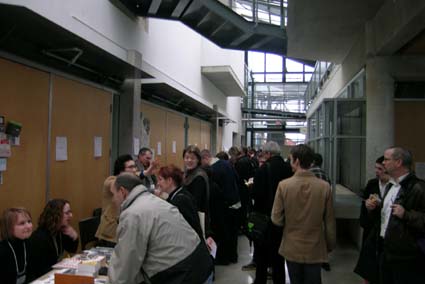
Networking Session
Another component of InFest was the linking up of exhibitions at Vancouver’s ARCs and Public Galleries via a series of staggered openings over three evenings during the symposium. The openings were linked in areas of proximity, the first being in the Yaletown area with Or Gallery, Helen Pitt Gallery, Centre A and Vancouver Contemporary Art Gallery. Centre A, a Public Gallery that focuses on work by Canadian and international Asian artists, presented an exhibition of past projects by Para/Site Art Space in Hong Kong. It included work and documentation from Transaction (1998), West Space’s first international exchange project.
The following four days included 5 discussion forums, 12 presentations by artist run organizations, more openings, tours of ARCs and a closing party. The organisers were cogniscent of the need to provide different levels of opportunity for discussion and engagement, this was especially the case with the forums.
The symposium was officially launched on the first day of forums (Thursday 26 February) by a project manager from the Canada Council reading a letter from Francois Lachapelle, the manager of the Visual Art Program. This direct and well informed presentation by the Canada Council set a tone of shared understanding by the Council and ARCs.
Two and a half days of forums (5 forums) followed utilizing different layers of involvement. Keith Wallace introduced the moderator for each panel. Each moderator was an artist and/or writer from Vancouver. The moderator then outlined the topic and introduced the panel members. Each panel member gave a brief presentation of 5 - 10 minutes, followed by questions to the panel members by the moderator for another 20 – 30 minutes. Panel members were briefed on the questions the moderator would ask through lead up e-mail correspondence. Some discussion had taken place surrounding the topic through this mechanism. Following the panel discussion the audience was invited to ask questions which lasted for about 30 minutes.
The first forum entitled ‘Mutations: What are ARCs?’ looked at the global phenomenon of artist run organizations and their shifting definitions. The moderator was Lorna Brown, Director/Curator at Artspeak with speakers Bastien Gilbert, Executive Director and co-founder of RCAAQ a service organization that represents more than 50 ARCs in Quebec; Jin-suk Suh, Director Alternative Space Loop, Seoul; and Sofie Sweger, United Net-Works, Stockholm.
At the completion of the forum, ‘break out’ discussions followed where sub topics developed from the main topic were addressed amongst smaller groups with more detail. The sub topics were read out by the moderator at the completion of the forum and written on blackboards at the entrance to the rooms they were respectively held in. A new moderator and note taker were appointed for each group. Four to five break out discussions allowed participants to move from one to the next if they so desired, though few participants chose to do this. The break out discussions ran for about 50 minutes. Brett Jones moderated a session on the ‘elastic, but strategic nature of networking amongst artist run organisations’.
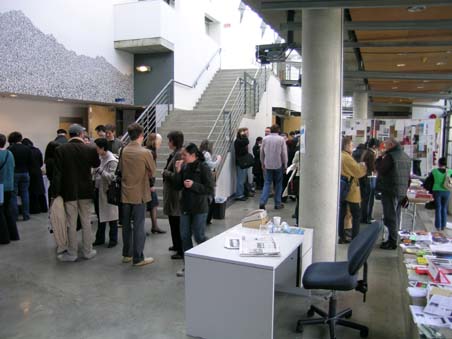
break between forums
In the afternoon the forum entitled ‘Survival of the Fittest: Funding and Artist Run Centres’ investigated how ARCs negotiate different funding environments and strategies for survival in different parts of the world. The moderator was Glenn Alteen, Director and Founder of Grunt Gallery with speakers Barbara Hunt, Executive Director, Artists Space, New York; Deirdre Kelly, Administrator, Cubbitt, London; and Gonzalo Lebrija, Oficina para Pryectos de Arte, Guadalajara, Mexico. More break out discussions followed.
The second day (Friday 27 February) of forums began with a ‘respondent’ providing a critique/analysis of the previous days proceedings. Warren Aracan, a local artist, presented his analysis for about 10 minutes before the first forum for the day was introduced, ‘Breeding Ground: Writing and Criticism in Artist Run Culture’. This forum probed into the role of writing, criticism and publishing as primary forms of sustenance for artist run culture, while asking ‘whether a distinct form of criticism is emerging in artist run culture’. It was moderated by Ashok Mathur, Head of Critical and Cultural Studies at Emily Carr Institute of Art and Design with speakers Justin Waddell Director of Programming, YYZ Artists’ Outlet, Toronto; Brett Jones, Director, West Space, Melbourne; and Leung Chi Wo, founding member, Para/Site Art Space Hong Kong. More breakout discussions followed.
In the afternoon the forum addressed the topic ‘Migratory Patterns: Internationalism and International Exchange’ asking questions surrounding the impacts of globalisation especially in relation to the formation of national identities and how artist run organizations negotiate their role in these processes. Moderated by Hank Bull, Director, Vancouver International Centre for Contemporary Asian Art (Centre A) with speakers Fiona Boundy, Gallery Director, Gasworks, London; Claudia Fontes, General co-ordinator, Trama, Buenos Aires; and Jean Mailloux, Programming Co-ordinator, La Chambre Blache, Quebec City. Breakout discussions followed.
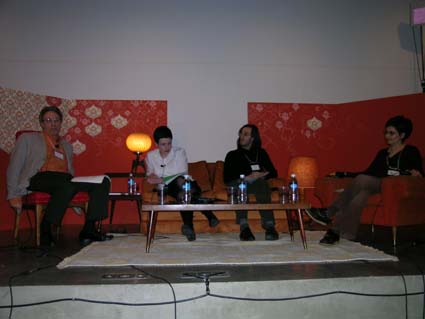
Migratory Patterns forum
That evening exhibitions opened at Gallery Grunt, Video In and Western Front. Organisation for Cultural Exchange and Disagreement (OCED) which opened at the Western Front was co-curated by Brett Jones and Jonathan Middleton with work by Alex Gawronski, John Barbour, Jane Finlay, Ruark Lewis, Sandra Bridie, Mark Soo, Nicole + Ryan, Kathleen Ritter and Derek Barnett.
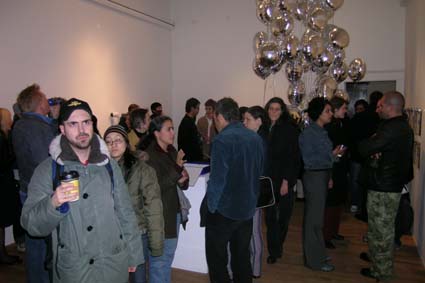
OCED Opening
The final forum day (Saturday 28 February) began with a respondent interpreting the previous days forums. Judy Radul analysed the previous days topics with the aid of some video footage. The final forum ‘Metamorphosis: The Artist as Curator’ looked at the increasing phenomenon of the artist as curator in Canadian ARCs, asking whether this new model will have an impact on curatorial practices and larger institutions. Moderated by Laiwan, artist and educator with speakers Jonathan Middleton, Exhibitions Curator, Western Front; Matthew Higgs, curator, Wattis Institute for Contemporary Arts, San Francisco; and Stephen Hobbs, the Trinity Session, Johannesburg.
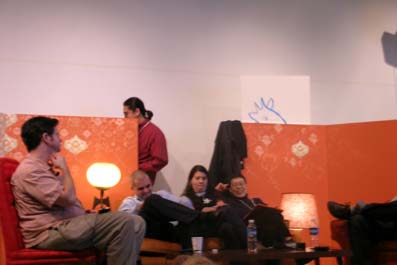
Metamorphisis forum
Saturday afternoon and Sunday morning were devoted to 30 minute presentations by various artist run organizations including Secession, Vienna; Trama, Buenos Aires; BASEKAMP, Philadelphia; Tribe Inc. Aboriginal Arts Collective, Saskatoon; Open Circle, Mumbai; Orgacom, Amsterdam; Oboro, Montreal and others.
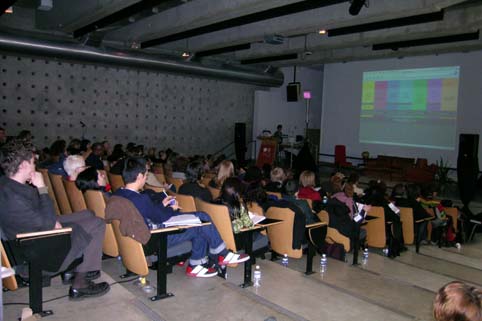
Space Presentation
Tours of Vancouver artist run oganisations took place on Sunday 29 February in the afternoon. The InFest party was held at Open Studios on the Saturday night.
The forums and presentations were well supported with translation headsets for French and English speakers. The set was designed by Vancouver artists Hadley Howes and Maxwell Stephens, making an important contribution to the ambience and vibe of the proceedings.
For details of the program: www.paarc.ca/infest
Comment
ARCs in Canada are clearly amongst the best resourced in the world. The federal, province and municipal governments all have funding programs directed towards ARCs. In particular the Canada Council has demonstrated strong support for ARCs since the early 70s. In the Visual Arts Program ARCs may apply under the areas of ‘Project Grants to Organisations’ or ‘Annual Grants to Organisations’. In the latter, two categories are managed: ‘Assistance to Art Museums and Public Galleries’ and ‘Assistance for Artist–Run Centres’. The grants ARCs receive under this category span three years and range from $20,000 - $100,000 per year. They can be used for all costs with the exception of capital costs.Public galleries, which may be considered similar to our Contemporary Art Spaces, may apply for $10,000 - $300,000 also with a three year commitment. They must not exceed 25% percent of an institutions revenue.
For details see: www.canadacouncil.ca/grants/visualarts
So what are the main differences between ARCs and Public Galleries in Canada?
On a structural level, ARCs ‘must be directed by a board composed of a majority of practicing contemporary visual artists’. But the most notable difference is based on the different roles expected of these two types of organizations. Public Galleries have a ‘mandate to serve the public’ in reference to a broad and varied general public. This means they provide access and education programs, they are responsible to ‘the public’ in the mainstream civic sense of the term. Whereas ARCs have a principle mandate that ‘encourages research, production, presentation, promotion and dissemination of new works in contemporary visual arts’ (Canada Council eligibility guidelines).
It is the emphasis that matters here as clearly there will be overlap. ARCs are expected to provide support and opportunities for artists through mechanisms of peer management and co-ordination. They do not have the pressure to address and involve a ‘broad public’ as the Public Galleries do. And they are much more orientated around processes of idea development and production for artists (R&D).
ARCs in Canada are recognised as providing vital and essential opportunities for artists to be involved with exhibition, advocacy, networking and exchange opportunities. The participation of artists at various levels within an artist run organization can be considered one of their non-transferable roles. These attitudes tie all artist run organizations together no matter whether they are large or small in their scale of operation.
Artist run organisations are critical to the development, production and presentation of work as a kind of ecological system that is always in formation; before, during and after the exhibition. Art produces ideas for its maker, itself and its audience, but this process is continual, it never stops. This is an important praxis which recognises art as a series of social interactions that are in a constant state of realisation.
The Canada Council understands these relationships having consistently and solidly supported ARCs since the early 1970s. Subsequently many have been operating for more than 20 years and some including the Western Front for around 30 years. The role of professional ARC associations such PAARC cannot be underestimated in assisting their long term survival. Besides PAARC in British Columbia, ARC associations operate in most Canadian provinces such as SaM in Saskatchewan and Manitoba, AAAG in Alberta (which includes Public Galleries), ARCCO in Ontario and notably RCAAQ in Quebec who publish an extensive guide to artist run centres across Canada and contracts for use by artists; Directory of Artist Run Centres in Quebec and Canada, Special Edition, 2002. See: www.rcaaq.org
Such associations are also instrumental in creating links between ARCs across Canada, that can extend outside Canada as can be seen with InFest. Infest has generated excellent opportunities for sharing knowledge and experience, disseminating information, connecting individuals and organizations, and generally learning about artist run activity in different cultural, political and geographic contexts.
InFest was very successful on several levels. It was very well managed and co-ordinated ; quite a large task with individuals flying in from all over the world with about 25 individuals invited as speakers, and many others representing their spaces as participants.
The organisers were thorough and comprehensive in their arrangements, including booking out a hotel for speakers and participants (though other accommodation was required as this one filled up). A shuttle bus was provided for people to get directly to Emily Carr. Information kits and maps were provided upon arrival.
Artists and organizations brought different experiences to InFest, and though agreement on issues was divergent (as it should be), the sense of a common cause was very evident. The knowledge and experience gained from the trip will be invaluable in assisting West Space and ARIs in Australia. The new contacts made and previous ones reinforced will provide a rich source for future exchange and correspondence with artists and their organizations in different parts of the world. More specifically the solid links built with artists and ARCs in Vancouver and Canada has formed a foundation with enormous potential. A network of international artist run spaces is evolving through these get togethers. (Brett Jones is speaking at another forum for artist run spaces, InBetween, Seoul in May 2004.)
Brett Jones’ involvement on the panel addressing writing and criticism coming out of artist run organizations was favourably received with much direct feedback. Individual discussions after the forum generated contacts with individuals and organizations with shared interests in this crucial area of artist run activity. West Space’s history of publishing demonstrated a range of options open to artist run organizations. Three key outcomes of publishing were presented from West Space’s experience:
- Publication as an oppositional space:
- for political purposes and processes
- agitation for change
- development of ideological positions
- provocation and contestation
- Publication as a site of advocacy:
- promotion of roles of artist run organizations in contemporary art
- documentation of issues concerning artists
- communication and networking with other artist run organizations and artists
- Publication as a site of research and learning:
- development of ideas and concepts in public form
- historical contextualisation (‘no one will write our histories but us’)
- Information for artists, students, general public, funding bodies, arts professionals etc.
The role of publications was presented as a core and enduring form of artistic production for West Space. The publication is a portable and mobile document that facilitates dialogue and exchange. It is also an important promotional tool for West Space, especially for those unable to visit the gallery space.
It has been long overdue for Australian ARIs to form sustainable contacts with their colleagues in Canada. The West Space relationship with the Western Front should represent a beginning for other Australian ARIs to forge professional relationships with Canadian artist run centres. Besides ARIs themselves, there are many things that artists, audiences and funding bodies can learn from the activities of ARCs in Canada. Not all practices are transferable of course, but Canada has the most closely aligned history concerning the development of the government supported non-profit visual arts sector. Therefore the sharing and contrasting of experiences amongst artist run organizations from the two countries seems a logical connection that is almost totally unexplored. In general, professional relationships by Australian artist run organizations with spaces in other countries are crucial to the development and recognition of ARIs here. A sustainable and long-term future for Australian ARIs will in part depend on looking beyond our own geographic and cultural conditions.
Brett Jones
24th April 2004
Brett Jones gratefully acknowledges the support of Australia Council,
the Commonwealth Governments Arts Funding and Advisory Body.


